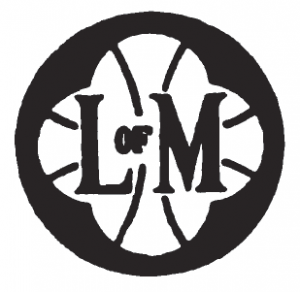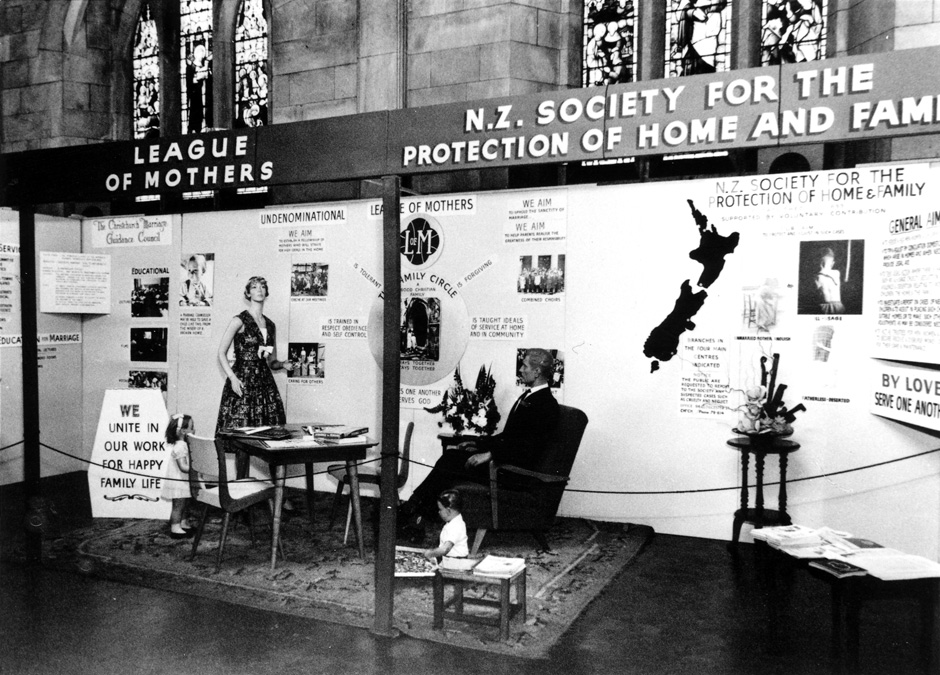
League of Mothers and Homemakers of New Zealand
1926 – 1996
Theme: Welfare
Known as:
- League of Mothers
1926 – 1987 - League of Mothers and Homemakers of New Zealand
1987 – 1996
This essay written by Bronwyn Labrum was first published in Women Together: a History of Women's Organisations in New Zealand in 1993. It was updated by Bronwyn Labrum in 2018.
1926–1993
The League of Mothers was a non-denominational Christian organisation which aimed to reach 'young mothers and all lonely women who are in need of Friendship and Fellowship'. [1] It was founded in 1926 by Lady Alice Fergusson, wife of the newly appointed Governor-General, and from then on had continuous vice-regal patronage.
A long-time member of the Scottish Mothers' Union, Lady Fergusson believed that the Mothers' Union in New Zealand (founded in 1886) was to all intents and purposes an Anglican organisation, and thus did not reach all mothers. In April 1926, at an Auckland meeting of about 70 women, including representatives of different churches and leaders of women's organisations, she proposed that a sister organisation be formed.
The founders adopted the aims and objectives of the Mothers' Union, and chose the name Auxiliary Mothers' Union. Three months later, when nine branches had been formed in Auckland, the name was changed to League of Mothers in order to stress its universal appeal and to avoid confusion with the Mothers' Union. The league's aims were to uphold Christian marriage and the duty of parents to bring their children up responsibly; to encourage children to grow in the Christian faith and show concern for others; and to set a good example within the family and community by its fellowship of women.
By 1927 14 branches had been established in Wellington, and in 1928 Southland was canvassed. Other provinces followed. Canterbury already had a strong Mothers' Union and no league branches were formed there until 1949. In 1927 the league published the first issue of its national magazine.
Although mothers were the league's principal focus, its concern to attract as many women as possible led to debates about eligibility. By 1930 the scope of membership had been extended to all married women, with or without children, with provision for associate membership for unmarried women 'interested in the care and upbringing of children'. [2] The league changed its name in 1987 to the League of Mothers and Homemakers of New Zealand. In the 1990s membership was open to 'all women who are willing to accept its aims and objects'. [3] In June 1991 the league had a membership of 3310 (including one man).
In its early years, the league made a special effort to reach women in small country towns and rural areas, introducing 'lighthouse' and 'scattered' branches for women unable to attend the monthly meetings. By 1934 the league was asking its provincial officers to concentrate on suburbs in larger provincial towns, a reflection of New Zealand's increasing urbanisation. In the mid-1930s the league briefly instigated separate 'daughters' branches for girls. In 1990 there were 90 branches nationwide, administered by nine provincial committees and a national executive.
Māori membership was encouraged from the start, and in 1929 a branch at Wairoa was established. The league hymn and prayer were translated into Māori, and in 1939 Lady Mīria Pōmare became vice-president of Māori and scattered branches. In 1958 it was agreed that financial aid for Māori branches would be granted on application.
The attractions of the league were many, particularly in its first decades. For church women it was an additional way to express their religious beliefs through welfare work in the community. It provided a social outlet for mothers at a time when alternatives were limited. According to one member, it 'gave young women a break from their children, yet at the same time benefited the children as they were able to mix and play together'. [4]
Monthly meetings usually featured a guest speaker and a competition (such as flower arranging), followed by afternoon tea. A creche was provided by volunteers, but in some branches they were later paid. Most groups had an annual fathers' night. Later league activities included outings, and knitting and handcraft groups.
The league performed more of an educative function by the 1980s, with branches particularly in larger centres holding seminars on such varied topics as drugs, family violence, club administration and public speaking. Welfare work included singing in homes for the elderly, hospital visiting, knitting and collecting clothes for the needy in the community, and fundraising for local and national charities, such as cancer research, the Schizophrenia Fellowship, and St John Ambulance. Branches also operated a friendship service, whereby members visiting another area could rely upon the local branch's hospitality and guidance.

Christchurch Anglican Diocesan Archives, Mother's Union Collection
League of Mothers and Society for the Protection of Home and Family displays in Christchurch during Christian Famly Year, 1962–1963.
While it served its members well, the league was not always successful in attracting new generations of women. As early as 1944, it called for suggestions for increasing its membership. Four years later it considered a name change to the League of Wives and Mothers in order to attract 'young marrieds', who were filling the new suburbs as cities spread and immigration was encouraged. But in 1952 Auckland members reported on the difficulties of forming branches in new housing areas because of the lack of suitable halls, and wondered if evening meetings were a solution. One member suggested in 1954 that the league should 'enrol women, primarily who were not connected with any church, and cater for younger women with modern ideas'. [5] Despite these mounting concerns, new branches continued to be formed. Membership rose from 4005 in 1930 to just over 11,000 in 1955.
By the mid-1970s, however, falling membership had become the league's 'greatest problem'. [6] It was also an aging membership - as early as 1953, one executive member declared that 'of over 70 meetings she had attended there were present very few women under 50', although this was hotly denied by other regions. [7] The league increasingly lost members ('the middle group') to the paid workforce. [8] Younger women, meanwhile, had different ideas and priorities: attendance fell off markedly for the Sanctity of Marriage talks, and the magazine editor found that there was demand for practical articles, such as knitting and medical advice. Alternative sources of childcare became available, and there were many other groups for women to join. These factors led to a reduction in the league's community work and in the numbers of women available to be branch or executive officers, and the drop in subscriptions undercut its administrative base. These problems still confronted the league in 1993.
The league's relationship with other women's organisations changed significantly over its lifetime. Initially it did not affiliate with other groups, as 'political' matters and even fundraising were felt to be firmly outside the league's province. There was, however, co-operation with Women's Institutes in rural areas with no branch of the league. But despite its suspicion of things political, the league did in fact work with like-minded groups as early as the 1930s on such issues as censorship, abortion, contraception, sex education and religious education, always from the perspective of concern for 'family values' and parental control, and a perception of declining moral standards in society. In International Women's Year (1975), the president's annual conference address focused on the league's child-rearing philosophy as a solution to the increasing numbers of families in distress in rapidly changing times. From 1953 the league was represented on the National Council of Women (NCW) executive, and NCW circulars and questionnaires provided much material for discussion at league meetings.
In the 1990s the league believed that mothers had been forgotten in a world which focused on greater public opportunities for women. In 1991 the president described the organisation as a 'group of caring women and Homemakers who are concerned about the Family Unit and the low status which is given to Mothers who stay home to nurture and care for their families'. [9] For most members, brought up in a different age, the league continued to provide support, education and an outlet for their talents. Although the needs of mothers as well as the community had changed significantly since 1926, the league maintained that its founding principles were as relevant as ever.
1994–1996
In its heyday the league had 22,000 members and 200 branches in New Zealand. By 1996 there were just 2200 members, and branches were closing. The League of Mothers and Homemakers of New Zealand officially wound up in April 1996. [10] The flow on effects of the changing concerns of women, apparent for the organisation from the 1970s, had accelerated. The membership continued to shrink and age, and their concerns were less attractive as more married women entered paid work and led different lives from those of the league’s stalwarts. Fewer were associated with churches, and greater urbanisation and suburbanisation was changing local communities. Late-twentieth-century mothers had different priorities from those of existing league members in an era of great social change. They did not see the value of the organisation, and in any case were not available to help run it in the way it had always been run. Other organisations that spoke to their concerns had developed and competed for their time, skills and subscription money.
The story of the league over its 70 years of existence is an instructive case study in how women’s lives and concerns changed over the twentieth century. Organisations have natural lives: they are established to meet a need and when that need changes, they are no longer viable. Many other long-standing organisations were facing this issue in the early twenty-first century.
Bronwyn Labrum
Notes
[1] League of Mothers, response to Women together survey, 1991.
[2] League of Mothers, How to form and work a branch, n.d., p. 5.
[3] League of Mothers and Homemakers of New Zealand, General directions and constitution, revised 1989, p. 1.
[4] Jean Dale, interviewed by Fiona McKergow, Wellington, 1992.
[5] 1954 Dominion Executive meeting minutes.
[6] National President's address to National Council, 47th annual report, p. 2.
[7] 1953 Executive meeting minutes.
[8] 54th annual report, p. 8.
[9] League of Mothers, response to Women together survey, 1991.
[10] Description of the Records of the Upper Hutt branch of the League of Mothers, Upper Hutt City Libraries, https://uhcl.recollect.co.nz/nodes/view/15173.
Unpublished sources
League of Mothers records, 1926–1996, ATL

Community contributions